WASHINGTON, D.C. -- The U.S. Payroll to Population employment rate (P2P), as measured by Gallup, was 43.7 % for the month of January, a decline from 44.4% in December.
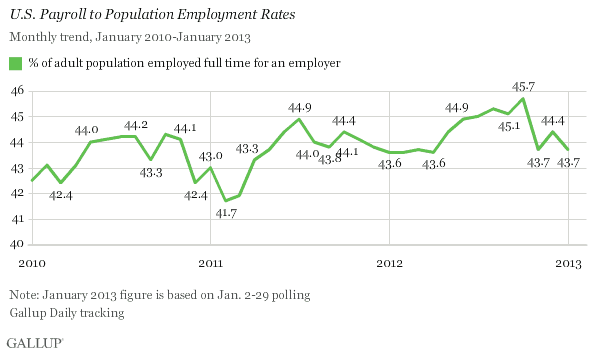
Gallup's P2P metric is an estimate of the percentage of the U.S. adult population aged 18 and older who are employed full time by an employer for at least 30 hours per week. P2P is not seasonally adjusted.
These results are based on Gallup Daily tracking interviews, conducted by landline and cellphone Jan. 2-29, with more than 27,000 Americans. Gallup does not count adults who are self-employed, working part time, unemployed, or out of the workforce as payroll-employed in the P2P metric.
Because of seasonal fluctuations, year-over-year comparisons are helpful in determining how much of the monthly changes are because of seasonal hiring patterns and how much are the result of growth in permanent full-time positions. January's P2P measure was nearly identical to the 43.6 measured in January 2012. This year-over-year comparison is an indication that the employment situation has changed little in the past year.
Seasonally Unadjusted Unemployment Unchanged in January
Unlike Gallup's P2P rate, which is a percentage of the total population, traditional employment metrics, such as the unemployment rates Gallup and the U.S. Bureau of Labor Statistics report, are based on the percentage of the workforce. Gallup defines "workforce" as adults who are working or actively looking for work and available for employment. December's workforce participate rate was 68.1%, an improvement over December 2012 (66.8%), but statistically similar to January 2012 (68.2 %).
Gallup's unadjusted unemployment rate for the U.S. workforce was 7.8% for the month of January, statistically unchanged from 7.7% at the end of December, but down from 8.6% a year ago. Gallup's seasonally adjusted unemployment rate for January was 7.3%, a 0.6-percentage-point decline from 7.9% in December. Gallup calculates a seasonally adjusted unemployment rate by applying the adjustment factor the government used for the same month in the previous year. Last year, the government adjusted December up by 0.2 points but adjusted January down by 0.5 points, which accounts for the decline.
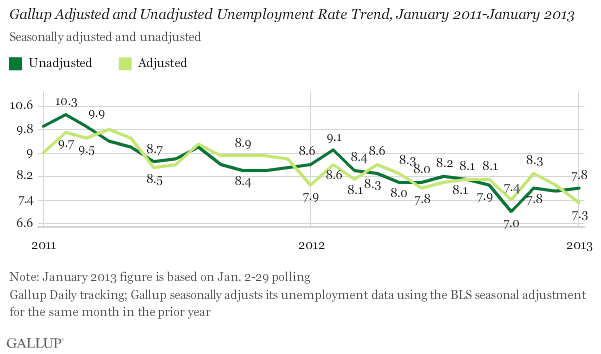
Underemployment, as measured without seasonal adjustment, was 17.4% in January, a slight uptick from 17.1% at the end of December. Still, underemployment improved by more than a point over January 2012, when the rate was 18.7%.
Gallup's U.S. underemployment rate combines the percentage of adults in the workforce who are unemployed with the percentage of those working part time but looking for full-time work.
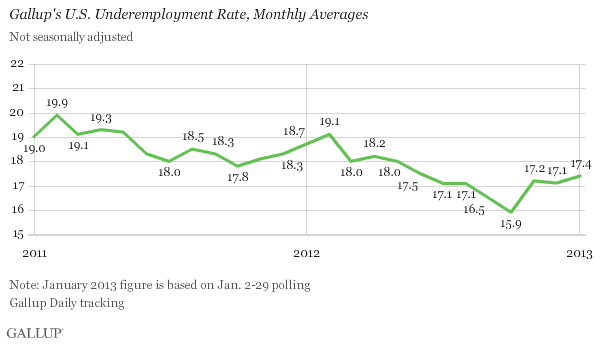
The percentage of workers working part time but wanting full-time work was 9.6% in January, up slightly from 9.4% in December. Compared with this time last year, the percentage of workers desiring additional work is down 0.5 points.
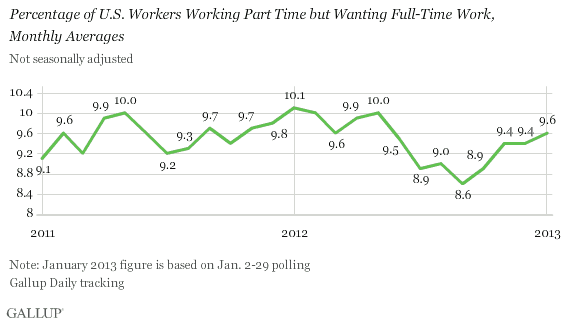
Implications
Gallup's seasonally adjusted unemployment rate -- the closest comparison it has to the official numbers the BLS releases -- declined in January to 7.3%, suggesting that the BLS may report a slight decline in unemployment when it releases its January number on Friday. Adjustment factors the BLS applies take into account seasonal fluctuations in hiring, such as extra hiring by retailers during the holiday season, or construction and farming increases in the summer. January's decline in Gallup's adjusted unemployment rate was the result of seasonal adjustment, but not a month-over-month change in the actual employment situation.
The year-over-year decline in unemployment and unchanged workforce participation would normally indicate an improving workforce if one were evaluating traditional employment metrics. However, P2P was flat, indicating that the percentage of U.S. adults finding good, full-time jobs for an employer has remained stagnant. Instead, job seekers have found part-time employment or self-employment. While these undoubtedly qualify as jobs and are better than unemployment, Gallup's global employment research has shown that these aren't the types of jobs that are linked to higher GDP. As the economy grows, P2P will show an increase.
There are reasons to be optimistic about P2P growth in the months ahead. Economic confidence, as measured by Gallup, is at its highest reading since Gallup began daily tracking five years ago, with the stock market experiencing a recent surge, and Congress reaching a fiscal cliff agreement. Whether these positive signs will give employers confidence to grow their workforces in 2013 remains to be seen.
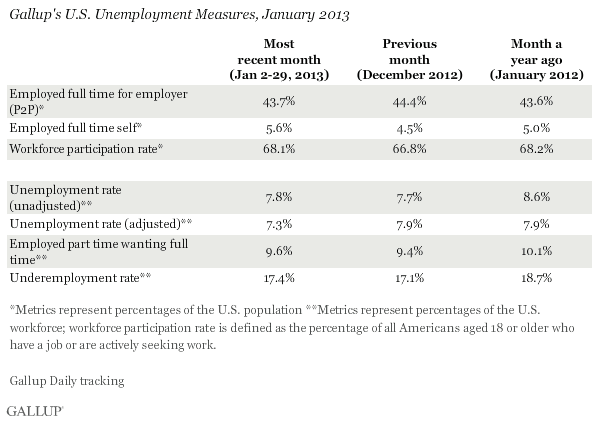
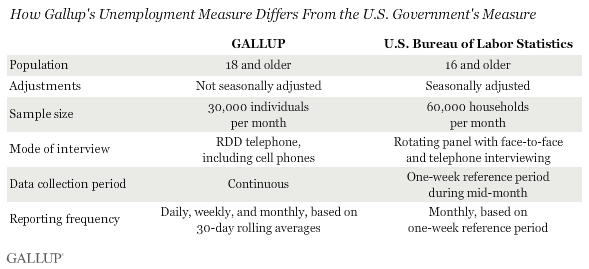
Gallup.com reports results from these indexes in daily, weekly, and monthly averages and in Gallup.com stories. Complete trend data are always available to view and export in the following charts:
Daily: Employment, Economic Confidence, Job Creation, Consumer Spending
Weekly: Employment, Economic Confidence, Job Creation, Consumer Spending
Read more about Gallup's economic measures.
View our economic release schedule.
Survey Methods
Results are based on telephone interviews conducted as part of Gallup Daily tracking from Jan. 2-29, 2013, with a random sample of 27,476 adults, aged 18 and older, living in all 50 U.S. states and the District of Columbia, selected using random-digit-dial sampling.
For results based on the total sample of national adults, one can say with 95% confidence that the maximum margin of sampling error is ±1 percentage point.
Interviews are conducted with respondents on landline telephones and cellular phones, with interviews conducted in Spanish for respondents who are primarily Spanish-speaking. Each sample of national adults includes a minimum quota of 50% cell phone respondents and 50% landline respondents, with additional minimum quotas by region. Landline telephone numbers are chosen at random among listed telephone numbers. Cell phones numbers are selected using random digit dial methods. Landline respondents are chosen at random within each household on the basis of which member had the most recent birthday.
Samples are weighted to correct for unequal selection probability, nonresponse, and double coverage of landline and cell users in the two sampling frames. They are also weighted to match the national demographics of gender, age, race, Hispanic ethnicity, education, region, population density, and phone status (cellphone only/landline only/both, cellphone mostly, and having an unlisted landline number). Demographic weighting targets are based on the March 2012 Current Population Survey figures for the aged 18 and older U.S. population. Phone status targets are based on the July-December 2011 National Health Interview Survey. Population density targets are based on the 2010 census. All reported margins of sampling error include the computed design effects for weighting.
In addition to sampling error, question wording and practical difficulties in conducting surveys can introduce error or bias into the findings of public opinion polls.
For more details on Gallup's polling methodology, visit www.gallup.com.
